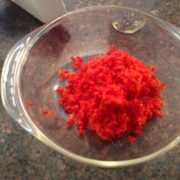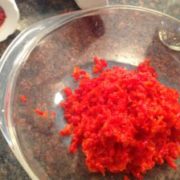Sweet Red Peppers
Sweet Red Peppers may be the answer to your search for something different. Perhaps a different ingredient, to be exact, that will bring the flavor of your dish to another level? You need not look beyond fresh sweet red peppers. I am not suggesting the use of raw, fried or roasted peppers, the crushed dried chili peppers, cayenne or hot sauces or even paprika. You might, in fact, have some of the for-mentioned in your arsenal of assorted pepper ingredients.
I am referring to the briny conserve made with sweet red peppers and well-known among Portuguese cooks, especially of the Alentejo Region in Portuguese. Sweet Red Pepper Paste which we refer to as Massa de Pimentão, is an iconic preparation of the region, that is held near and dear to our hearts. A scant teaspoon or tablespoon, is added judiciously to seasoning rubs. Dishes of poultry, fish, meats, even rice, potatoes or scrambled eggs are infused with a distinctive flavor. Often layered with paprika and even a dash or two of hot sauce, gives a dish another dimension. However, additional salt is usually not needed, but always taste the dish before adding any additional salt.
Carne de Porco à Alentejana (Alentejo-Style Pork with Clams) is an iconic dish of the Alentejo. Sweet Red Pepper Paste, when added, gives the meat and sauce unique signature flavor. The Sweet Red Pepper paste is easy to make. However, it needs a minimum of 3-5 days of letting the salted peppers to stand and drain their water.
As a young girl, at the age of 10, I learned to make this briny concoction of sweet red pepper paste under the tutelage of my father. He learned just as I did but under the watchful eye of my grandmother as she learned the method before him. I embraced his lessons as we cut and seeded the peppers, as we discussed what else but cooking. Carrying on the teaching tradition, I explained methods to my children and now my grandchildren. One is when you make this from scratch, you know the quality of the peppers and salt that is used. But yes, you can purchase a commercial brand in a Portuguese market or online. Just be sure the ingredients are just salt and sweet red peppers. and a touch of olive oil.
The only equipment needed is a wooden box and a stainless steel or non-corrosive sheet pan. My father used slatted wooden boxes obtained from produce markets. Check with your local market. They are more difficult to get today. However, if you know a handy person, all you need to make this box are ¼-inch thick wood slats.
For the base, 1-inch by ¼-inch slats are tacked or stapled ¼-inch apart to a 9 x 12 x 3–inch rectangular frame, leaving a narrow space between the vertical sides and the base edge for drainage. The 12-inch sides of the wood frame are made up of two 1 ¼ -inch slats spaced ¼-inch apart. If all else fails, use a large rectangular, fine mesh footed sieve that is often used to straddle a sink. Line the sieve with a single or double layer of cheese cloth. This will retain the salt, but it will allow drainage. If you make the cloth lining too thick it will not allow proper drainage. See the detailed recipe in Portuguese Home Cooking.




Thank you